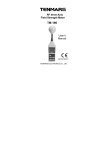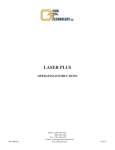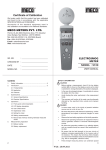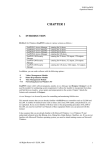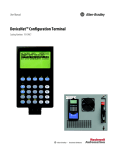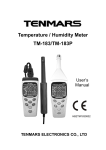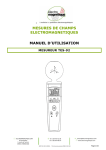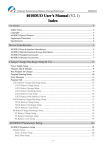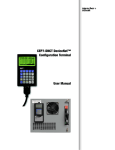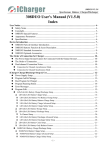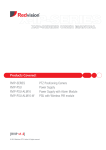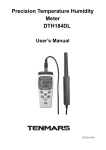Download TM-181 Hygro-Thermometer說明書
Transcript
RF three-Axle Field Strength Meter TM-195 User’s Manual HB2TM1950000 Table of Contents 1 Introduction............................................................................... 1 2 Simple a method of operation.................................................. 1 3 Fundamentals........................................................................... 1 3.1 Electric field strength (E):...................................................2 3.2 Magnetic field strength (H):................................................2 3.3 Power density (S):..............................................................3 3.4 The characteristic of electromagnetic fields:.....................3 4 Application................................................................................. 5 5 Features.................................................................................... 7 6 Identifying Parts........................................................................9 7 LCD description....................................................................... 11 8 Specifications..........................................................................12 8.1 General specifications.....................................................12 8.2 Electrical specifications....................................................15 8.3 Units of measurement......................................................18 8.4 Result modes...................................................................18 9 Measurement Procedures and Preparation...........................20 9.1 POWER button ............................................................... 20 9.2 Data hold button:..............................................................20 9.3 Units button: .................................................................... 21 9.4 MAX / AVG Record:......................................................... 22 9.5 Manual data memory storing ..........................................22 9.6 Backlight Display and Reading in The Dark....................23 9.7 XYZ/CALL:.......................................................................23 9.8 Alarm ON/OFF Setup.......................................................23 9.9 Viewing Data Records..................................................... 24 9.10 Clock LCD Display......................................................... 25 10 Setup Mode........................................................................... 27 10.1 Clock Setup-1................................................................. 27 10.2 Setting the alarm limit value (ALARM)-2.......................28 10.3 DEL data logger memorysetup-3...................................30 10.4 Analogue bar graphsetup-4........................................... 30 10.5 Auto Power Off Time function setup-5...........................31 10.6 Setting the calibration factor (CAL)-6............................32 11 Making measurements ........................................................ 34 12 Short-term measurements ................................................... 34 13 Long-term exposure measurements ...................................36 14 SAFETY INFORMATION...................................................... 36 15 SAFETY INFORMATION...................................................... 38 16 Battery replacement.............................................................. 40 17 Safety Precaution................................................................. 40 18 End of life.............................................................................. 41 1 Introduction This meter is designed for measuring and monitoring Radio– Frequency electromagnetic field strength. The meter is calibrated precisely over the frequency range of 50Mz~3.5 GHZ. 2 Simple a method of operation Press button to power on. To change measuring unit (mV/m), push “ ”button to change the unit.Electric field strength (V/m).Computed magnetic field strength (mA /m). Computed power density (mW/m2).Computed power density (μW/cm2). Press this key to change sensor axis selector :”All axis” → “X axis “→ “Y axis” → “Z axis”. 3 Fundamentals Electromagnetic pollution: EN-1 This meter is used to indicate electromagnetic pollution generated artificially. Wherever there is a voltage or a current, electric (E) and magnetic (H) fields arise. All types of radio broadcasting and TV transmitters produce electromagnetic fields, and they also arise in industry, business and the home, where they affect us even if our sense organs perceive nothing. 3.1 Electric field strength (E): A field vector quantity that represents the force (F) on an infinitesimal unit positive test charge (q) at a point divided by that charge. Electric field strength is expressed in units of volts per meter (mV/m). This meter measures electric field strength directly. 3.2 Magnetic field strength (H): A field vector that is equal to the magnetic flux density divided by the permeability of the medium. Magnetic field strength is EN-2 expressed in units of amperes per meter (A/m). In far field situations, one can calculate the magnetic field for the electric field value. This meter can display the calculated magnetic field strength. 3.3 Power density (S): Power per unit area normal to the direction of propagation, usually expressed in units of watts per square meter (W/m2) or, for convenience, units such as mill watts per square centimeter (mW/cm2). 3.4 The characteristic of electromagnetic fields: Electromagnetic fields propagate as waves and travel at the speed of light (C). The wavelength is proportional to the frequency. EN-3 λ (wavelength) = C (speed of light) / f (frequency) If the distance to the field source is less than three wavelengths, then we are usually in the near field. If the distance is more than three wavelengths, the far-field conditions usually hold. In near field conditions, the magnetic field value cannot be calculated from the electric field value. This meter is designed for reliable far field measurements only. EN-4 4 Application Quite often routine, maintenance and service work has to be done in areas where active electromagnetic fields are present, e.g. in broadcasting stations, etc. Additionally, other employees may be exposed to electromagnetic radiation. In such cases, it is essential that personnel be not exposed to dangerous levels of electromagnetic radiation, such as: High frequency(RF)electromagnetic wave field strength measurement. Mobile phone base station antenna radiation power density measurement. Wireless communication applications (CW, TDMA, GSM, DECT). RF power measurement for transmitters. EN-5 Wireless LAN (Wi-Fi) detection, installation. Spy camera, wireless bug finder. Cellular /Cordless phone radiation safety level. Microwave oven leakage detection. Personal living environment EMF safety. EN-6 5 Features The meter is a broadband device for monitoring highfrequency radiation in the range from 50MHz to 3.5GHz The non-directional electric field antenna and high sensitivity also allow measurements of electric field strength in TEM cells and absorber rooms. The unit of measurement and the measurement types have been selected to expressed in units of electrical and magnetic field strength and power density. At high frequencies, the power density is of particular significance. It provides a measure of the power absorbed by EN-7 a person exposed to the field. This power level must be kept as low as possible at high frequencies. The meter can be set to display the instantaneous value, the maximum value measured or the average value. Instantaneous and maximum value measurements are useful for orientation, e.g. when first entering an exposed area. For isotropic measurements of electromagnetic fields. Non-directional (isotropic) measurement with three-channel measurement sensor. High dynamic range due to three- channel digital results processing. Configurable alarm threshold and memory function. Easy & safe to use Low battery detector “ Over load indication “OL”. ”. EN-8 6 Identifying Parts EN-9 1. RF three-Axle Sensor. 2. Liquid-crystal LCD 3. MAX / AVG Button. 4. Record / Time Button. 5. Power Button. 6. UNIT / ENTER switch Button. 7. Hold / Up Button. EN-10 7 8. Backlight/Down Button. 9. XYZ / MEM button. 10. Tripod mounting screw. 11. Battery cover. LCD description EN-11 1. Primary Display 13. E symbol 2. Hold symbol 14. Auto power off symbol 3. Analogue bar graph 15. Time unit (month:day) 4. MAX symbol (hour: minute) (second) 5. AVG symbol 16. MEM reading symbol 6. Low battery symbol 17. SET symbol 7. x1x10x100 unit 18. REC symbol 8. X.Y.Z unit 19. CAL symbol 9. ALARM unit 20. Secondary Display 10. mV/m,V/m (E) 21. BUZZER symbol 11. µA/m mA /m unit (H) 22. Decimal point 12. µW/m, µW/cm2unit 8 Specifications 8.1 General specifications Display type: Liquid-crystal (LCD), 4-1/2 digits maximum reading 19999. EN-12 Measurement method: Digital, triaxial measurement. Directional characteristic: Isotropic, triaxial. Measurement range selection: one continuous range. Display resolution:0. 1mV/m, 0.1µA/m, 0.001µW/m2, 0.001µW/cm2 Setting time: typically 1.5s (0 to 90% measurement value.) Sample rate: 1.5 times per second. Audible alarm: Buzzer. Units: mV/m, V/m, µA/m, mA/m, µW/m2, mW/m2, µW/cm2 Display value: Instantaneous measured value, maximum value, average value, or maximum average value. Alarm function: adjustable threshold with ON / OFF Calibration factor CAL: adjustable Manual data memory and read storage:200 data sets. Batteries: 9V NEDA 1604, IEC 6F22 or JIS 006P Battery life: Approximate 15 hours. Auto power off: Default time 15 minutes. Adjustable threshold 0~99 minutes. EN-13 Operating temperature range: 0°C to + 50°C Operating humidity range: 25% to 75 % RH Storage temperatures range: -10°C to +60°C Storage humidity range: 0% to 80% RH Dimensions: 60(L)*60(W)*195(H) mm. Weight (including battery): Approx.200g. Accessories: User’s manual, 9V battery, Carrying case. EMC This tester was designed in accordance with EMC Standards in force and its compatibility has been tested in accordance with EN61326-1 (2006). EN-14 8.2 Electrical specifications Unless otherwise stated, the following specifications hold under the following conditions: The meter is located in the far field of a source; the sensor head is pointed towards the source. Ambient temperature: +23 °C ±3°C. Relative air humidity 25%~75% Sensor type: electrical field (E). Frequency range: 50MHz ~ 3.5GHz. Specified measurement range: CW signal (f >50MHz): EN-15 0.01V/m~ 20.0 V/m. 0.1mA/m ~ 532.6mA/m, 0.01W/m2~106.94mW/m2. Dynamic range: Typically 75dB. Absolute error at 1V/m and 2.45GHz: ± 1.0 dB. Frequency response: Sensor taking into account the typical CAL factor: ± 2.4dB (50 MHz to 1.9 GHz). ±1.0 dB (1.9 GHz to 3.5GHz). Isotropy deviation: Typically ± 1.0 dB (f 2.45GHz). Overload limit: 0.42 EN-16 mW/cm2 (11 V/m) per axis. Overload limit: (0 to50°C): ± 0.2dB. EN-17 8.3 Units of measurement The meter measures the electrical component of the field; the default units are those of electrical field strength (mV/m or V/m). The meter converts the measurement values to the other units of measurement, i.e. the corresponding magnetic field strength units (µA/m or mA/m) and power density units (µW/m2 , mW/m2 or µW/cm2 ) using the standard far-field formulate for electromagnetic radiation. The conversion is invalid for near-field measurements, as there is no generally valid relationship between electrical and magnetic field strength in this situation. Always use the default units of the sensor when making near-field measurements. 8.4 Result modes The bar graph display always shows the instantaneous measured dynamic range value. The digital display shows the result according to one of three modes, which can be selected. EN-18 Instantaneous: The display shows the last value measured value measured by the sensor, no symbol is displayed. Maximum instantaneous (MAX):The digital display shows the highest instantaneous value measured, the “MAX “symbol is displayed. Average (AVG): The digital display shows the average value measured, the “AVG” symbol is displayed. Instantaneous mode is the default setting when the meter is turned on. The following graph shows of Instantaneous (actual), MAX (hold), AVG and MAX/AVG: EN-19 9 Measurement Procedures and Preparation Battery loading: Remove the battery cover on the back and put a 9V battery inside. Battery replacement: When the symbol of “ ” appears on the LCD display, the battery should be replaced with a new one. The battery symbol will be displayed on the LCD, this is a battery low indicator. 9.1 POWER button: Press button to power on. Again Press button to power off. 9.2 Data hold button: Press the “ ” button to go into hold mode, and “HOLD” appears on the screen to allow you to read the data. Press “ ”this button once again to deactivate it. EN-20 9.3 Units button: Change units with the “UNITS” key as follows. Electric field strength (V/m) Computed magnetic field strength (mA/m). Computed power density (mW/m2). Computed power density (μW/cm2). Press “ ” button and push “ ”button to change the unit. Possible units: mV/m, V/m, µA/m , mA/m, µW/m2, mW/m2, µW/cm2 EN-21 9.4 MAX / AVG Record: Press “ ” key to switch to the next display. The display switches from MAX to AVG to MAX/AVG and back to MAX. Press and hold “ ”key for 3 seconds to disable this function. The maximum storage is up to 99 minutes and 99 seconds After this period of time, updating will be completed automatically and then the LCD displays . 9.5 Manual data memory storing Push“ ”button, the meter will save the current measured result, and REC with a number 001~200 will appear. Manual data Manual data memory storing: 200 data sets. Over load indication: “OL”. EN-22 9.6 Backlight Display and Reading in The Dark. Press “ ”key backlight light on. Again Press button to power off. Backlight light turns off automatically after 30 seconds. 9.7 XYZ/CALL: Press this key to change sensor axis selector :”All axis” → “X axis “→ “Y axis” → “Z axis”. 9.8 Alarm ON/OFF Setup Press hold and key to switch the alarm function on The “ALARM” symbols in the display indicates that the alarm EN-23 function is on. Press hold and key to turn off the alarm function. When the Alarm is ON, the display shows . 9.9 Viewing Data Records Press hold “ ”button and press“ ”button to view the saved data records Use “ Press ” or “ ” button to see the next or previous records key to close the setup, exit the mode. EN-24 9.10 Clock LCD Display Press hold and button for more than seconds to select the display method of the Year, Month, Date, hour and Second. This meter’s clock uses 24 hour time setting. Default time mode setting is “2010/01/07 00: 02” “:00”. EN-25 EN-26 10 Setup Mode Press hold “ ” button and “ ” button to enter the setup mode. Press “ ” button to change the setup function. (Setup function see Note1) Push “ ” button to save setup data Note1: you can set up 6 different functions in setup mode Clock Setup setup 1 : Setting the alarm limit value (ALARM) setup 2 : Clear data logger memory setup 3 : Analogue bar graph X1.X10.X100 setup 4 : Auto Power Off Time setup 5 : Setting the calibration factor (CAL) 10.1 Clock Setup-1 Press hold “ ” button and press “ to enable Clock Setup EN-27 ” button first This meter clock is 24 hour time setting. Use “ ” or “ ” to select the digit you want to adjust Use “ ” or “ ” button to change digit(Hour→day→Month→year→Minute). Press “ ” button to save the setting. Date/Time default format:2009/12/21 12:12. Year format: 2000~2099 display as 00 ~ 99. 10.2 Setting the alarm limit value (ALARM)-2 The alarm limit value is used to monitor the display value automatically. It controls the alarm indication function. The EN-28 alarm limit value can be edited in the displayed V/m unit. The ALARM setting range is from 0.001 to 999.9V/m. ALARM default is set at 999.9V/m. Alarm limit function is only used for total three axial value comparator. Press and hold on “ ”button and press “ ” button to Setup Mode then press button twice to turn on the meter to enter the alarm set ting mode, the ”V/m” unit is flashing displayed. Press ““and “ Press “ ” button to change digit key the one of four digit is flashing displayed. Press “ ” key to select the desired setting value. Press “ ” key to store the new setting value and exit. EN-29 10.3 DEL data logger memorysetup-3 Press and hold on “ ”button and press “ ” button to Setup Mode Press button three times to clear data logger memory for last record setting mode (3.SET). Press” ’’ Press key in the display ‘’ key to clear data logger memory for last record and exit the mode. Press ” key “in the display Press key to clear data logger memory for last record. 10.4 Analogue bar graphsetup-4 Press hold “ ” button and press “ ” button to Setup Mode Press button four times to: Analogue bar graph setting mode the ” graph” unit is flashing displayed X1 X10 X100. EN-30 Press“ ” “and “ “ ” to select the desired setting value X1 X10 X100 Press “ ” key to store the new setting value and exit. 10.5 Auto Power Off Time function setup-5 If you want to disable auto power off, please hold “ and press “ push “ ” button ” button to Setup Mode ” button five times, the auto power off symbol will not display on the LCD. Press “ Press “ symbol “and “ ” button to change digit. ” key to store the new setting value and exit.the is displayed. Maximum auto power off time:00~99 minutes. Auto power off time default setting is 15 minutes. EN-31 10.6 Setting the calibration factor (CAL)-6 please hold “ ” button and press “ ” button to Setup Mode press “ ” button six times to turn on the meter to enter the calibration factor, The CAL setting range is from 0.10 to 9.99. Press “ Use “ “and “ ” or “ ” button to change digit ” to select the desired setting value. on the meter to enter the calibration factor setting mode, the “ CAL SET ” marks is displayed. Press “ ” key to store the new setting value and exit. Calibration factor (CAL) The calibration factor CAL serves to calibrate the result display. EN-32 The field strength value measured internally is multiplied by the value of CAL that has been entered and the resulting value is displayed. The CAL setting range is from 0.10 to 9.99. The CAL factor is often used as a means of entering the sensitivity of the field sensor in terms of its frequency response in order to improve measurement accuracy. EN-33 11 Making measurements Important: The following effect will be noted with all field strength meters: If the sensor is moved quickly, excessive field strength values could be displayed. This effect is caused by electrostatic charges. Recommendation: Hold the meter steady during the measurement. 12 Short-term measurements Application: Use either the “instantaneous” or the “Max. instantaneous” mode, if the characteristics and orientation of the field are unknown when entering an area exposed to electromagnetic radiation. Procedure: Hold the meter at arm’s length. EN-34 Make several measurements at various locations around your work place or the interested areas as described above. This is particularly important is the field conditions are unknown. Pay special attention to measuring the vicinity of possible radiation sources. Apart from active sources, those components connected to a source may also act as radiators. For example , the cables used in diathermy equipment may also radiate electromagnetic energy. Note that metallic objects within the field may locally concentrate or amplify the field from a distant source. EN-35 13 Long-term exposure measurements Location Place the meter between yourself and the suspected source of radiation. Make measurements at those points where parts of your body are nearest to the source of radiation. Note: Use the “Average” or” Max average” modes only when the instantaneous measurement values are fluctuating greatly. You may fix the meter to a wooden or plastic tripod. 14 SAFETY INFORMATION CAUTION EN-36 Before making a measurement, check if the low battery symbol” ” is shown on the display as soon as the meter is switched on. Change the battery if the symbol is displayed. In the case of prolonged storage, it is preferable to remove the battery from the meter. Avoid shaking the meter, particularly in the measurement mode. The specified limits outside and improper handling may adversely affect the accuracy and function of the meter. EN-37 15 SAFETY INFORMATION DANGER EN-38 In some cases, work in the vicinity of powerful radiation sources can be a risk of your life. Be aware that persons with electronic implants (e.g. cardiac pacemakers) are subject to particular dangers in some cases. Observe the local safety regulations of the facility operation. Observe the operating instructions for equipment, which is used to generate, conduct, or consumer electromagnetic energy. Be aware that secondary radiators (e.g. reflective objects such as a metallic fence) can cause a local amplification of the field. Be aware that the field strength in the near vicinity of radiators increases proportionally to the inverse cube of the distance. This means that enormous field strengths can result in the immediate vicinity of small radiation sources (e.g. leak in wave guides, inductive ovens) Field strength measuring EN-39device can underrate pulsed 16 Battery replacement Turn off the instrument. WARNING If the symbol “ ” appears on the LCD, please replace the battery immediately Remove the battery cover Replace the battery. Install the battery cover. 17 Safety Precaution For cleaning the EN-40 instrument use a soft dry cloth. Never use a wet cloth, solvents or water, etc.. Operation Altitude: Up to 2000M. Operating Environment: Indoors use. This instrument has been designed for being used in an environment of pollution degree 2. 18 End of life Caution: this symbol indicates that equipment and its accessories shall be subject to a separate collection and correct disposal EN-41 EN-42 EN-1 EN-2 TENMARS ELECTRONICS CO., LTD 6F, 586, RUI GUANG ROAD, NEIHU, TAIPEI 114, TAIWAN. E-mail : [email protected] http : //www.tenmars.com





















































